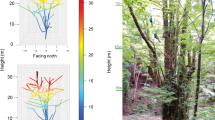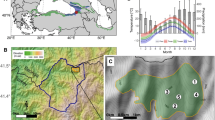Abstract
Canopy-forming shrubs are reported to be increasing at sites around the circumpolar Arctic. Our results indicate expansion in canopy cover and height of willows on Herschel Island located at 70° north on the western Arctic coast of the Yukon Territory. We examined historic photographs, repeated vegetation surveys, and conducted monitoring of long-term plots and found evidence of increases of each of the dominant canopy-forming willow species (Salix richardsonii, Salix glauca and Salix pulchra), during the twentieth century. A simple model of patch initiation indicates that the majority of willow patches for each of these species became established between 1910 and 1960, with stem ages and maximum growth rates indicating that some patches could have established as late as the 1980s. Collectively, these results suggest that willow species are increasing in canopy cover and height on Herschel Island. We did not find evidence that expansion of willow patches is currently limited by herbivory, disease, or growing conditions.







Similar content being viewed by others
References
ACIA. 2005. Arctic Climate Impact Assessment—scientific report, 1st ed. Cambridge: Cambridge University Press.
Ainsworth, C., G. Leprovost, and A. Stokes. 2001. Wood formation in trees. Plant Physiology 127: 1513–1523.
Arft, A.M., M.D. Walker, J. Gurevitch, J.M. Alatalo, M.S. Bret-Harte, M. Dale, M. Diemer, F. Gugerli, et al. 1999. Responses of tundra plants to experimental warming: Meta-analysis of the International Tundra Experiment. Ecological Monographs 69: 491–511.
Argus, G.W., C.L. McJannet, and M.J. Dallwitz. 1999. Salicaceae of the Canadian Arctic Archipelago: Descriptions, illustrations, identification, and information retrieval. Version: 29 March 1999. In Flora of the Canadian Arctic archipelago, ed. S. Aiken, M. Dallwitz, L. Consaul, C. McJannet, R. Boles, G. Argus, J. Gillett, P. Scott, et al. (2003). NRC Research Press. http://www.mun.ca/biology/delta/arcticf/. Retrieved 4 March 2010.
Bigelow, N.H., L.B. Brubaker, M.E. Edwards, S.P. Harrison, I.C. Prentice, P.M. Anderson, A.A. Andreev, P.J. Bartlein, T.R. Christensen, W. Cramer, et al. 2003. Climate change and Arctic ecosystems: 1. Vegetation changes north of 55 N between the last glacial maximum, mid-Holocene, and present. Journal of Geophysicsal Research 108:8170.
Blok, D., U. Sass-Klaassen, G. Schaepman-Strub, M.M.P.D. Heijmans, P. Sauren, and F. Berendse. 2011. What are the main climate drivers for shrub growth in Northeastern Siberian tundra? Biogeosciences 8: 1169–1179.
Brubaker, L.B., H.L. Garfinkee, and M.E. Edwards. 1983. A late Wisconsin and Holocene vegetation history from the central brooks range: Implications for Alaskan palaeoecology. Quaternary Research 20: 194–214.
Burn, C.R., and Y. Zhang. 2009. Permafrost and climate change at Herschel Island (Qikiqtaruq), Yukon Territory, Canada. Journal of Geophysical Research 114: F02001.
Chapin, F.S., G.R. Shaver, A.E. Giblin, K.J. Nadelhoffer, and J.A. Laundre. 1995. Responses of Arctic tundra to experimental and observed changes in climate. Ecology 76: 694–711.
Chapin, F.S., M. Sturm, M.C. Serreze, J.P. McFadden, J.R. Key, A.H. Lloyd, A.D. McGuire, T.S. Rupp, et al. 2005. Role of land-surface changes in Arctic summer warming. Science 310: 657–660.
de Witte, L.C., and J. Stöcklin. 2010. Longevity of clonal plants: Why it matters and how to measure it. Annals of Botany 106: 859–870.
Dormann, C.F., and S.J. Woodin. 2002. Climate change in the Arctic: Using plant functional types in a meta-analysis of field experiments. Functional Ecology 16: 4–17.
Dudley, L.S. 2006. Ecological correlates of secondary sexual dimorphism in Salix glauca (Salicaceae). American Journal of Botany 93: 1775–1783.
Elmqvist, T., J. Ågren, and A. Tunlid. 1988. Sexual dimorphism and between-year variation in flowering, fruit set and pollinator behaviour in a boreal willow. Oikos 53: 58–66.
Euskirchen, E.S., A.D. McGuire, F.S. Chapin, S. Yi, and C.D.C. Thompson. 2009. Changes in vegetation in northern Alaska under scenarios of climate change, 2003–2100: Implications for climate feedbacks. Ecological Applications 19: 1022–1043.
Forbes, B.C., M.M. Fauria, and P. Zetterberg. 2010a. Russian Arctic warming and ‘greening’ are closely tracked by tundra shrub willows. Global Change Biology 16: 1542–1554.
Forbes, B.C., F. Stammler, T. Kumpula, N. Meschtyb, A. Pajunen, and E. Kaarlejarvia. 2010b. High resilience in the Yamal-Nenets social–ecological system, West Siberian Arctic, Russia. Proceedings of the National Academy of Sciences 106: 22041–22048.
Hallinger, M., M. Manthey, and M. Wilmking. 2010. Establishing a missing link: Warm summers and winter snow cover promote shrub expansion into alpine tundra in Scandinavia. New Phytologist 186: 890–899.
Hardy Associates Ltd. 1979. Vegetation of King Point, Pauline Cove and Baillie Islands/prepared for Dome Petroleum Ltd., published report. Calgary: Hardy Associates Ltd.
Hofgaard, A., L. Dalen, and H. Hytteborn. 2009. Tree recruitment above the treeline and potential for climate-driven treeline change. Journal of Vegetation Science 20: 1133–1144.
Hofgaard, A., J.O. Løkken, L. Dalen, and H. Hytteborn. 2010. Comparing warming and grazing effects on birch growth in an alpine environment—a 10-year experiment. Plant Ecology and Diversity 3: 19–27.
Hollister, R.D., P.J. Webber, and C.E. Tweedie. 2005. The response of Alaskan Arctic tundra to experimental warming: Differences between short- and long-term responses. Global Change Biology 11: 525–536.
Inter-Disciplinary Systems Ltd. 1972. Report on the Herschel Island Environmental Reconnaissance for Amoco Cana Petroleum Co. Ltd. Unpublished Report, Inter-Disciplinary Systems Ltd, Winnipeg, MB, Canada.
Johnstone, J.F., and S.V. Kokelj. 2008. Environmental conditions and vegetation recovery at abandoned drilling mud sumps in the Mackenzie Delta region, Northwest Territories, Canada. Arctic 61: 199–211.
Kemper, J.T., and S.E. Macdonald. 2009. Directional change in upland tundra plant communities 20–30 years after seismic exploration in the Canadian low-Arctic. Journal of Vegetation Science 20: 557–567.
Kennedy, C.E., C.A.S. Smith, and D.A. Cooley. 2001. Observations of change in the cover of Polargrass, Arctagrostis latifolia, and Arctic Lupine, Lupinus arcticus, in upland tundra on Herschel Island, Yukon Territory. Canadian Field-Naturalist 115: 323–328.
Lantuit, H., and W. Pollard. 2008. Fifty years of coastal erosion and retrogressive thaw slump activity on Herschel Island, southern Beaufort Sea, Yukon Territory, Canada. Geomorphology 95: 84–102.
Lantz, T.C., S.E. Gergel, and G.H.R. Henry. 2010. Response of green alder (Alnus viridis subsp. fruticosa) patch dynamics and plant community composition to fire and regional temperature in north-western Canada. Journal of Biogeography 37: 1597–1610.
Lantz, T.C., S.V. Kokelj, S.E. Gergel, and G.H.R. Henry. 2009. Relative impacts of disturbance and temperature: Persistent changes in microenvironment and vegetation in retrogressive thaw slumps. Global Change Biology 15: 1664–1675.
Mackay J.R., and Burn C.R. 2011. A century (1910–2008) of change in a collapsing pingo, Parry Peninsula, Western Arctic Coast, Canada. Permafrost and Periglacial Processes 22. doi:10.1002/ppp.723.
Molau, U., and P. Mølgaard. 1996. International Tundra Experiment (ITEX). http://www.geog.ubc.ca/itex/library/index.php. Retrieved 1 November 2010.
Munier, A., L. Hermanutz, J.D. Jacobs, and K. Lewis. 2010. The interacting effects of temperature, ground disturbance, and herbivory on seedling establishment: Implications for treeline advance with climate warming. Plant Ecology 210: 19–30.
Myers-Smith, I.H. 2011. Shrub encroachment in Arctic and alpine tundra: Mechanisms of expansion and ecosystem impacts. PhD Thesis, University of Alberta.
Olofsson, J., L. Oksanen, T. Callaghan, P.E. Hulme, T. Oksanen, and O. Suominen. 2009. Herbivores inhibit climate-driven shrub expansion on the tundra. Global Change Biology 15: 2681–2693.
Post, E., and C. Pedersen. 2008. Opposing plant community responses to warming with and without herbivores. Proceedings of the National Academy of Sciences 105: 12353–12358.
Predavec, M., and K. Danell. 2001. The role of lemming herbivory in the sex ratio and shoot demography of willow populations. Oikos 92: 459–466.
Smith, C.A.S., C.E. Kennedy, A.E. Hargrave, and K.M. McKenna. 1989. Soil and vegetation of Herschel Island. Research Branch, Agriculture Canada.
Speed, J.D.M., G. Austrheim, A.J. Hester, and A. Mysterud. 2010. Experimental evidence for herbivore limitation of the treeline. Ecology 91: 3414–3420.
Speed, J.D.M., G. Austrheim, A.J. Hester, and A. Mysterud. 2011. Growth limitation of mountain birch caused by sheep browsing at the altitudinal treeline. Forest Ecology and Management 261: 1344–1352.
Sturm, M., C.H. Racine, and K.D. Tape. 2001. Increasing shrub abundance in the Arctic. Nature 411: 546–547.
Tape, K.D., M. Sturm, and C.H. Racine. 2006. The evidence for shrub expansion in Northern Alaska and the Pan-Arctic. Global Change Biology 12: 686–702.
Thorpe, N., S. Eyegetok, N. Hakongak, and K. Elders. 2002. Nowadays it is not the same: Inuit Quajimajatuqangit, climate caribou in the Kitikmeot region of Nunavut, Canada. In The Earth is Faster Now: Indigenous Observations of Arctic Environmental Change, ed. I. Krupnik, and D. Jolly, pp. 198–239. Fairbanks/Washington, DC: Arctic Research Consortium of the United States/Smithsonian Institution.
van Wijk, M.T., K.E. Clemmensen, G.R. Shaver, M. Williams, T.V. Callaghan, F.S. Chapin, J.H.C. Cornelissen, L. Gough, et al. 2004. Long-term ecosystem level experiments at Toolik Lake, Alaska, and at Abisko, Northern Sweden: Generalizations and differences in ecosystem and plant type responses to global change. Global Change Biology 10: 105–123.
Wahren, C.H., M.D. Walker, and M.S. Bret-Harte. 2005. Vegetation responses in Alaskan Arctic tundra after 8 years of a summer warming and winter snow manipulation experiment. Global Change Biology 11: 537–552.
Walker, M.D., C.H. Wahren, R.D. Hollister, G.H.R. Henry, L.E. Ahlquist, J.M. Alatalo, M.S. Bret-Harte, M.P. Calef, et al. 2006. Plant community responses to experimental warming across the tundra biome. Proceedings of the National Academy of Sciences of the United States of America 103: 1342–1346.
Yukon Territorial Government, Heritage Branch. 2001. Virtual Museum Canada—Herschel Island. http://www.virtualmuseum.ca/Exhibitions/Herschel/English/menu.html. Retrieved 16 November 2010.
Acknowledgments
The authors wish to thank C.R. Burn for reading and providing helpful comments on the manuscript; D. Reid, S. Gilbert, and V. Loewen for field logistical support; and F. Doyle for contributing repeat photographs. The authors also wish to thank Qikiqtaruk–Herschel Island Territorial Park wardens and park management, in particular, Lee John Meyook and Richard Gordon; the 2008 and 2009 ArcticWOLVES Herschel Island field crews, M. Grabowski, C. Henry, and A. Trimble for field assistance; David Neufeld for providing old photographs; and the Aurora Research Institute for theirr logistical support. Support in the form of funds received from the Government of Canada International Polar Year Program, NSERC, the Polar Continental Shelf Program, the Canon National Parks Science Scholars Program, the Alberta Ingenuity, W. Garfield Weston Foundation, the Northern Scientific Training Program INAC, and the C-BAR Grant Program, the Canadian Circumpolar Institute, and the Air North (flight discounts) is gratefully acknowledged. The authors thank the Inuvialuit people for the opportunity to conduct research on their traditional lands.
Author information
Authors and Affiliations
Corresponding author
Electronic supplementary material
Below is the link to the electronic supplementary material.
Rights and permissions
About this article
Cite this article
Myers-Smith, I.H., Hik, D.S., Kennedy, C. et al. Expansion of Canopy-Forming Willows Over the Twentieth Century on Herschel Island, Yukon Territory, Canada. AMBIO 40, 610–623 (2011). https://doi.org/10.1007/s13280-011-0168-y
Published:
Issue Date:
DOI: https://doi.org/10.1007/s13280-011-0168-y




